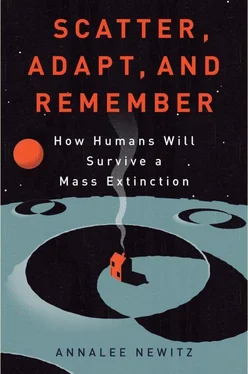If our progeny do make it that far, it will be because humanity has chosen exploration over warfare often enough that we’ve managed to work together as a planet on several large projects. One of those projects would be pushing our species off this rock, scattering us through the solar system. This project is important for reasons that go beyond how great it would be to fly through Saturn’s rings. It’s also important as a long-term human goal because most of the steps that lead to its realization will take us down the pathway of survival rather than death.

In this image taken by the international space probe Cassini, we got our first glimpse of the ethane and methane lakes surrounded by sand dunes on the surface of Saturn’s moon Titan. (illustration credit ill.20)
Planning for Life Beyond Earth
“Our kids are the last generation who will see no city lights on the Moon,” the NASA Jet Propulsion Lab’s Randii Wessen told me when we talked about the economic feasibility of space travel. Though his prediction isn’t outside the realm of possibility, we should also think pragmatically about the path to space. Wessen’s colleague the atmospheric physicist Armin Kleinboehl is far more conservative in his estimates of when humans might live beyond Earth. Kleinboehl studies Martian weather via the Martian Reconnaissance Orbiter (MRO), a craft that has been photographing and analyzing the Martian surface from orbit since 2006. When we met, he showed me some MRO images of dust storms that periodically envelop all of Mars, making it even colder than it is normally. When I asked Kleinboehl what he thought the timeline might be for a Mars colony, he frowned and glanced over at a video simulation of Martian weather. “It won’t be attractive for at least five hundred years,” he said finally. “It’s not very hospitable.” When I asked about terraforming, Kleinboehl conceded that that was one way Mars might eventually become habitable. Perhaps we could cultivate plants or bacteria on Mars that photosynthesize, pop out free oxygen, and change the environment.
Though it’s popular to imagine that humans will be exploring the galaxy in Star Trek style over the next couple of centuries, this leap may take a little longer. And that’s good news. By the time we’re ready to set up tourist resorts on Titan, we may have reached the point as a civilization that we won’t “fuck everything up,” as synbio designer Daisy Ginsberg so succinctly put it.
It’s not very popular to suggest that the future could happen slowly, or that tomorrow’s scientific innovations might take as much time as they have historically. Futurists like Ray Kurzweil are fond of suggesting that the pace of discovery is “accelerating,” and that change will move at a blindingly rapid clip over the next century. While anything is possible, we shouldn’t expect immortality, superintelligence, and faster-than-light travel in our lifetimes. Anticipating instantaneous, radical change diverts us from investing time in long-haul projects like building safer, sustainable cities and planning for food security. These are the kinds of scientific endeavors that can help us survive while we’re waiting for somebody (or some thing ) to invent upload technology. I’m not suggesting that we should slow down the pace of scientific discovery. Quite the opposite. I’m saying we should focus our scientific and technological energies on problems that are solvable in the near term, while always keeping our eyes on the long-term goal of exploring and adapting to worlds beyond our blue marble.
If we’ve learned anything from the survivors among our ancestors, it’s that staying put and fighting change are not good tactics if we want to live. Survivors range over vast regions. If they encounter adversity in one environment, they try to escape and adapt to a new environment. Survivors prefer the bravery of exploration to the bravery of battle. But present-day humans differ dramatically from most of Earth’s survivors in one crucial way. We can make plans for the future. And with the help of scientifically informed models, we can also consider how we would deal with many possible future scenarios. What if an asteroid hit? A flood? A plague? A drought? Right now, we have many excellent ways of figuring out how each of these species-ending disasters might unfold—and we have ways of preventing most of them from killing us all.
Surviving is partly a matter of implementing what we already know. But it’s also about planning to deal with disasters we know for certain aren’t survivable right now. Those are the kinds of disasters that require us to build cities on Mars, Titan, Europa, the Moon, asteroids, and any other uninhabited chunk of matter we can find. The more we explore, the more likely it is that our species will make it.
Perhaps no research plan expresses this idea better than the 100 Year Starship, a project run by the doctor and former astronaut Mae Jemison. The project, initially funded by the U.S. government, is now a nonprofit organization whose goal is to develop a starship capable of bringing humans to another star system. It’s called 100 Year Starship because Jemison and her colleagues estimate that it will take roughly a century to develop the technology. Though this time period is short compared with the million-year view I was just describing, it’s still longer than pretty much any other scientific project currently under way. I asked Jemison why she had set a goal beyond her lifetime and that of anybody working on the project now. It was both pragmatic and necessary, she said. The technologies needed are far beyond our current levels of development. And, she added, we need time “to create a movement here on Earth, imbuing society with the aspiration to get this accomplished.” Calling the mission “optimistic,” she added that she and the scientists associated with the project will be developing several technologies along the way to their goal which could be useful in themselves. Perhaps they’ll create a better kind of propulsion, or new hydroponic systems for growing plants in space. “Weightlessness could be a platform,” she mused, where we could stage any number of experiments before taking off for the next habitable star system. Her point also holds true for the science we’ll develop as we prepare to build a space elevator and an asteroid-nudging fleet—it may help us back on Earth.
One of the scientists already studying what life might be like elsewhere in our solar system is the planetary scientist Nathalie Cabrol. She conducts missions for the SETI Institute, where she studies remote environments on Earth that are similar to environments we might find on Mars, Titan, or Europa. In the rocky peaks of the Andes mountains, where the atmosphere is thin, she and her team dive deep into lakes whose chemical compositions are rare for earthly bodies of water. There, Cabrol told me that they look for the kinds of life that could thrive on another world; they also try to figure out what would survive if Earth underwent a radical environmental change. Cabrol’s team is making discoveries that are relevant for the near future and the far future. And in the process, they may discover something totally unexpected.
Cabrol explained that one of her current projects is to develop a robotic rover that could land on an unexplored world—like, say, in the oceans of Jupiter’s moon Europa —and figure out what it should be studying. Because the robot would be on a totally new world, it would need to be able to get a baseline for what was normal there, and then judge what aspects of the environment were extraordinary or worth studying in greater detail. To explore Europa, in other words, we have to build a robot that can think like a scientist, taking in data and deciding which pieces of that data are salient. Work like Jemison’s and Cabrol’s led the celebrated science historian Richard Rhodes to speculate at the space exploration conference SETICon in 2012 that one unintended consequence of space exploration might be the emergence of artificial intelligence. So Nick Bostrom’s intelligence explosion could happen on Europa rather than on Earth.
Читать дальше







![Аннали Ньюиц - Автономность [litres]](/books/424681/annali-nyuic-avtonomnost-litres-thumb.webp)





